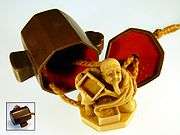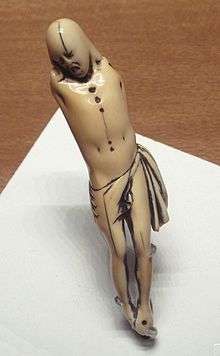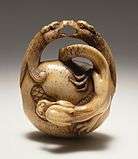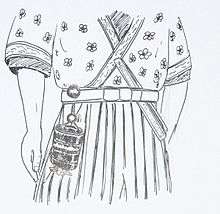Netsuke
Netsuke (根付) [netsu͍ke] (singular the same) are miniature sculptures that were invented in 17th-century Japan to serve a practical function (the two Japanese characters ne+tsuke mean "root" and "to attach"). Traditional Japanese garments—robes called kosode and kimono—had no pockets; however, men who wore them needed a place to store their personal belongings, such as pipes, tobacco, money, seals, or medicines. In English the word may be italicized or not, with American English tending to favour the former and British English the later.[1][2]
Their solution was to place such objects in containers (called sagemono) hung by cords from the robes' sashes (obi). The containers may have been pouches or small woven baskets, but the most popular were beautifully crafted boxes (inrō), which were held shut by ojime, which were sliding beads on cords. Whatever the form of the container, the fastener that secured the cord at the top of the sash was a carved, button-like toggle called a netsuke.
Netsuke, like the inrō and ojime, evolved over time from being strictly utilitarian into objects of great artistic merit and an expression of extraordinary craftsmanship. Such objects have a long history reflecting the important aspects of Japanese folklore and life. Netsuke production was most popular during the Edo period in Japan, around 1615–1868. Today, the art lives on, and some modern works can command high prices in the UK, Europe, the USA, Japan and elsewhere. Inexpensive yet faithful reproductions are available in museums and souvenir shops.
Okimono, small and purely decorative sculptures, were often made by the same artists who produced netsuke.
Forms
- katabori-netsuke (形彫根付) or "sculpture netsuke" - This is the most common type of netsuke. They are compact three-dimensional figures carved in a round shape and are usually around one to three inches high.
- anabori-netsuke (穴彫根付) or "hollowed netsuke" - subset of katabori which are carved out for a hollow center. Clams are most commonly the motifs for this type of netsuke.
- sashi-netsuke (差根付) - This is an elongated form of katabori, literally "stab" netsuke, similar in length to the sticks and gourds used as improvised netsuke before carved pieces were produced. They are about six inches long.
- obi-hasami - another elongated netsuke with a curved top and bottom. It sits behind the obi with the curved ends visible above and below the obi.
- men-netsuke (面根付) or "mask netsuke" - the largest category after katabori. These were often imitations of full-size noh masks and share characteristics in common with both katabori and manju/kagamibuta.
- manjū-netsuke (饅頭根付) - a thick, flat, round netsuke, with carving usually done in relief, sometimes made of two ivory halves. Shaped like a manjū, a Japanese confection.
- ryūsa-netsuke (柳左根付)- shaped like a manjū, but carved like lace, so that light is transmitted through the item.
- kagamibuta-netsuke (鏡蓋根付) or "mirror-lid netsuke" - shaped like a manjū, but with a metal disc serving as a lid to a shallow bowl, usually of ivory. The metal is often highly decorated with a wide variety of metallurgical techniques.
- karakuri-netsuke (からくり根付) or "trick/mechanism netsuke" - any netsuke that has moving parts or hidden surprises.
 Katabori-netsuke front and rear view with two holes for cord
Katabori-netsuke front and rear view with two holes for cord Anabori-netsuke
Anabori-netsuke Mask netsuke
Mask netsuke Ryūsa-netsuke
Ryūsa-netsuke Manjū-netsuke
Manjū-netsuke Kagamibuta-netsuke
Kagamibuta-netsuke Trick netsuke
Trick netsuke Obi-hasami sashi-netsuke
Obi-hasami sashi-netsuke
Materials
.jpg)
- ivory - the most common material used before ivory from live animals became illegal. Netsuke made from mammoth ivory (huge quantities still exist in the Near East and Siberia) fill part of the tourist trade demand today.
- boxwood, other hardwoods - popular materials in Edo Japan and still used today
- metal - used as accents in many netsuke and kagamibuta lids
- hippopotamus tooth - used in lieu of ivory today
- boar tusk - mostly used by the Iwami carvers
- rhinoceros horn
- clay/porcelain
- lacquer
- cane (woven)
Unusual materials [3]
- hornbill ivory: of the many species of hornbill, only the helmeted hornbill (Buceros vigil or Rhinoplax vigil) furnishes an ivory-like substance. This is a dense, carvable substance that makes up the solid casque growing above the upper mandible (from the bird's forehead). It is not ivory, horn, or bone, yet it has been called ivory for many centuries. It is softer than real ivory and is a creamy yellow in color, becoming red at the top and sides.
- umimatsu: a species of black coral with dense texture, concentric growth rings, and amber and reddish colored inclusions in the black material. According to Michael Birch, "the literal translation of umimatsu is 'sea pine', and it is also popularly described as 'black coral'. True coral, however, is a hard calcareous substance secreted by marine polyps for habitation. Umimatsu, on the other hand is a colony of keratinous antipatharian marine organisms."[4]
- According to Bushell (13/ 2:6), "The literal translation... is seapine.... Whether literal or figurative the translation is a misnomer, as the material is, in actuality, a coral formed by skeletons of living organisms.... In color, umimatsu, black coral, is black or blackish brown, sometimes showing streaks of light brown or dirty yellow." Bushell goes on: "As material, umimatsu is more acceptable to collectors than carvers. Leading carvers naturally avoided the material. It was prone to crack, crumble or chip. Carvers find that it is risky for carving details and subtle effects. Perfect pieces of black coral were difficult to obtain."
- umoregi: there are several definitions, some contradictory: According to Bushell, "Umoregi is a partially fossilized wood, having the general appearance of ebony but showing no grain." Often called fossilized wood, umoregi is not properly a wood, but a "jet" (a variety of lignite), that is often confused with ebony. It is a shiny material that takes an excellent polish, but it has a tendency to split. Umoregi is petrified wood formed when cedar and pine trees from the Tertiary Age (5 million years ago) were buried underground and then carbonized. The layers of earth where umoregi-zaiku can be found extend under the Aobayama and Yagiyama sections of Sendai, [Japan]. Pieces made from this material are generally dark brown with a beautiful wood grain and the soft luster of lacquer.
- walrus tusk: walrus have two large tusks (elongated canine teeth) projecting downward from the upper jaw. These tusks, often reaching two feet in length, have been extensively carved as ivory for centuries in many countries and especially in Japan. Walrus tusk carvings are usually easy to identify, because much of the interior of the tooth is filled with a mottled, almost translucent substance that is harder and more resistant to carving than the rest of the tooth. Manju, especially ryusa manju, invariably show this translucent material at opposite edges of the netsuke.
- whale's tooth: the sperm whale has teeth running the whole length of its enormous lower jaw. Those in the middle tend to be the largest, often obtaining a length of more than six to eight inches. These larger ones are often used by carvers of scrimshaw. Drexler: "I have a smaller whale's tooth that is just about the size that each of several of my netsuke might have been carved from."
- whale bone: all bones are hollow, the cavity being filled with a spongy material. Cuts across some bone show a pattern of minute holes looking like dark dots. Lengthwise, such bone displays many narrow channels which appear to be dark lines of varying lengths. Polished, bone is more opaque and less shiny than ivory.
- teeth: a variety of other teeth are used for netsuke, including: boars', bears', and even tigers'.
- tagua nut: the nut from the ivory palm (Phytelephas aequatorialis), often referred to as vegetable ivory. Part of the nut's shell sometimes remains on netsuke carvings. Though often mistaken for or deceptively sold as elephant ivory, items made from the two-to-three-inch nut have none of the striations common to animal ivory, and sometimes the ivory-like nut flesh has a light yellow cast under a rough coconut-shell-like external covering. The nut is very hard when dry, but easily worked into artistic items when wet.
- walnut (or kurumi - natural walnut shell): in this rare example of the kataborinetsuke (形彫根付) style, the meat from the nut was removed by various means, one being the insertion of a small worm in a hole in the nut to consume the meat. Following that, elaborate designs were carved, and the string inserted. The carver often removed all of the nut's normal surface features and carved through the surface in places to create a latticed effect. Once carved, the resulting netsuke was polished and shellacked.
- bamboo: "bamboo (Iyo bamboo) is used for netsuke. Bamboo netsuke are either a piece of the stem or the root with carving on it."[5] According to Bernard Rosett (14/2 :40-44): "carvings in the round are usually made from the underground stem of the plant, that small almost solid zone that connects to the creeping rhizome below the ground. Bamboo netsuke are not commonly encountered. Occasionally, one comes across a netsuke fashioned from bamboo root and can revel in the wonderful texture and patina of the material."
- agate: a mineral, streaked with many colors, and which can be given a high polish.
- ivorine: a material made from the dust created when carving legally obtained new ivory, mammoth ivory, tusks, and teeth, which is then mixed with a clear resin and compressed as it hardens. This was one of the many solutions to the demand of the tourist market trade for netsuke carvings after trade in new ivory became illegal. Once hard and dry, ivorine can be carved in exactly the same way as ivory. Though often deceptively sold to the modern tourist trade as elephant ivory, items made from ivorine have none of the striations common to animal ivory, though sometimes, the carving is artificially aged to have the yellowed appearance common to true old ivory carvings.
Subjects
Like many other art forms, netsuke reflect the nature of the society that produced them. This effect is particularly pronounced in netsuke, owing to long periods of isolation imposed both by geography and internal politics and limited avenues of self-expression for Japanese citizens due to custom and law.[6][7][8] As a result, netsuke display every aspect of Japanese culture, including its rich folklore and religion, crafts, trades, and professions, all types of people and creatures, both real and imagined, and every kind of object. As in other aspects of Japanese culture, the subjects portrayed by netsuke trend, over the long term, away from an initial emphasis on motifs of Chinese derivation toward a focus on objects of more strictly national interest.[9]
- people - famous and anonymous, current, historical, real and fictitious, children, warriors, priests, etc.
- craft, trades, professions - often depicting actions (fishermen catching fish, woodcutters cutting wood), or examples(i.e., a stylized apple for an orchardist or apple merchant)[10]
- animals - zodiac animals and others. It is worth noting that traditional netsuke style depicts octopus figures as having a tube-like siphon protruding from the "face", similar to a mouth. If one examines closely, one will find that some octopuses have nine tentacles instead of eight. These octopi will usually be found embracing beautiful women.
- plants or plant products - small ones, such as beans or chestnuts, are often carved actual size.
- deities and mythical creatures - often from Chinese mythology and religion, and Seven Lucky Gods, are the seven gods of good fortune in Japanese mythology and folklore.
- non-living things - the smallest category. Common examples include roof tiles, coins, and tools.
- abstract - mon patterns and other designs
- sexual - shunga netsuke may depict a male and female in sexual conjugation or may contain only subtle or symbolic sexual references.
Some netsuke represent single, simple, objects, and some depict entire scenes from history, mythology, or literature.
 Jewel of Wisdom carved with mountain pavilions. Stained ivory
Jewel of Wisdom carved with mountain pavilions. Stained ivory Kirishitan netsuke depicting the Christ, 17th century
Kirishitan netsuke depicting the Christ, 17th century Dragons on gong
Dragons on gong- Mouse on barrel
- Ivory netsuke with sitting boy
- Fukurokuju, Benten and boy
Cultural references
Netsuke are the main subject of the book The Hare with Amber Eyes by Edmund de Waal. The book traces the history of a collection of 264 netsuke - some of them by well-known craftsmen - which were taken to France in the late 19th century, and bought by a member of the wealthy Jewish Ephrussi family. They were later given to the family's Vienna branch, where a family servant kept them hidden during the Holocaust when the Nazis confiscated the family's other possessions. In 1947, the netsuke were taken back to Japan by a surviving family member who went to live in Tokyo.
See also
References
- ↑ "Netsuke: From Fashion Fobs to Coveted Collectibles", Metropolitan Museum of Art
- ↑ "Netsuke & Inro", Victoria & Albert Museum
- ↑ 2005 INS conference Burt Drexler lecture, unless otherwise noted
- ↑ Lazarnick, George "Netsuke & Inro Artists, and How to Read Their Signatures", page 1361, Reed Publishers, 1981
- ↑ Yuzuru Okada, "Netsuke A Miniature Art of Japan", page 54, Japan Travel Bureau, 1951
- ↑ Okada, Barbra "Japanese Netsuke and Ojime From the Herman and Paul Jaehne Collection of the Newark Museum", pages 3-4
- ↑ Bushell, Raymond "The Netsuke Handbook of Ueda Reikichi", pages 25-26, Charles E. Tuttle, 1961
- ↑ Sadao, Tsuneko S. and Wada, Stephanie "Discovering the Arts of Japan, A Historical Overview", page 202 and page 234, Kodansha International, 2003
- ↑ F.M. Jonas, "Netsuke" page 44, J.L. Thompson & Co., 1928
- ↑ F.M. Jonas, "Netsuke", J.L. Thompson & Co., 1928
External links
| Wikimedia Commons has media related to Netsuke. |
- International Netsuke Society This organization publishes a journal for collectors and holds international meetings bi-annually. The Society's web site shows examples of different styles. Others can be found by searching the Internet.
- Isaac Kaplan Netsuke Collection. The South African Jewish Museum's collection of over 600 netsuke. The museum's permanent exhibit displays over 200 netsuke from the 17th-19th centuries.
- Japanese Netsuke History and background on various types of netsuke
- Netsuke thumbnail gallery with detailed images at the Bolton Museum web site
- KYOTO SEISHU NETSUKE ART MUSEUM There are many excellent collection that mainly of contemporary pieces, but with some beautiful antique netsuke as well.
- Netsuke: masterpieces from the Metropolitan Museum of Art, an exhibition catalog from The Metropolitan Museum of Art (fully available online as PDF)
- Sumo: Netsuke and Okimono: From the collection of Karl-Ludwig Kley , an online catalogue of Sumo themed Netsuke.
